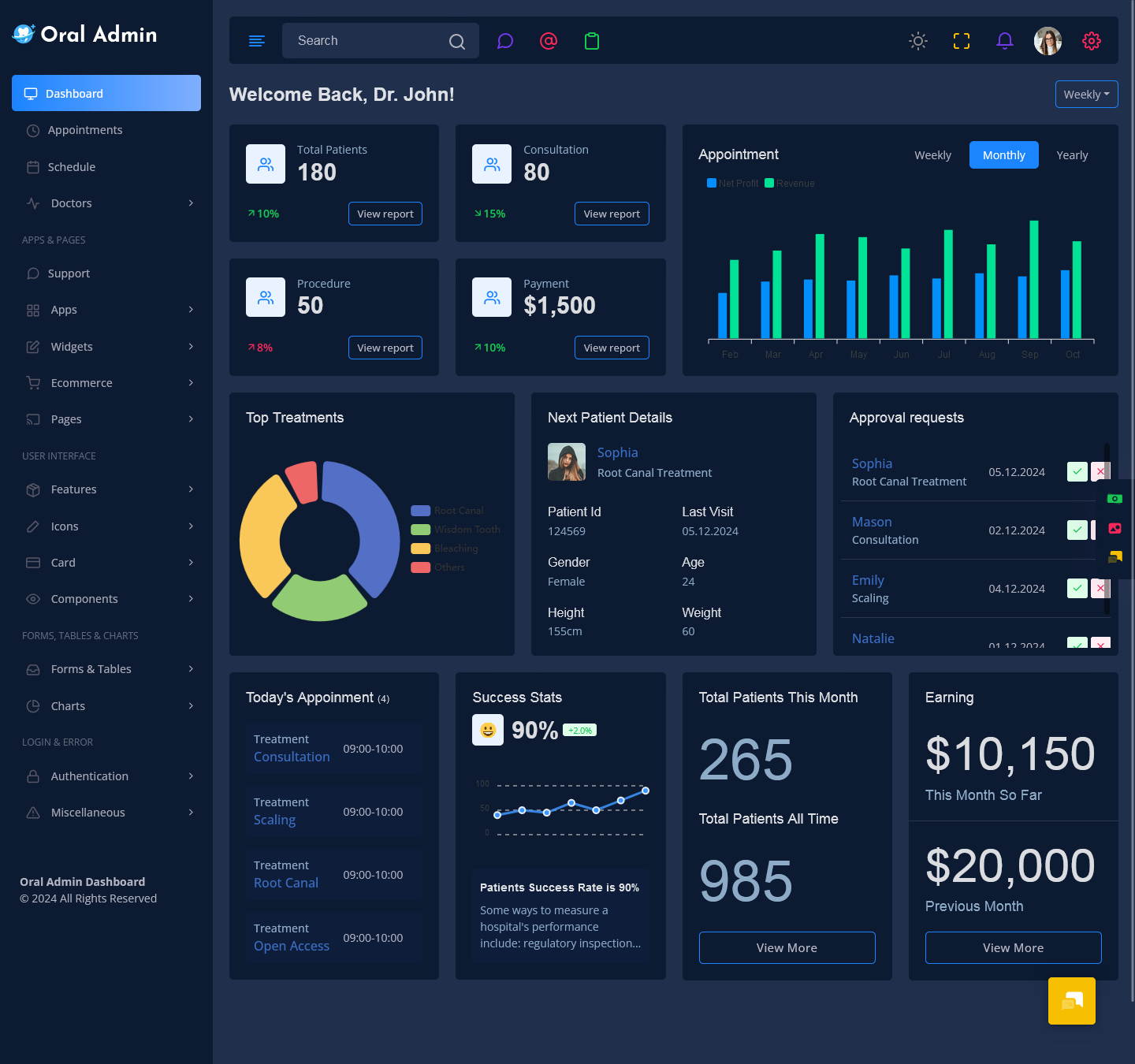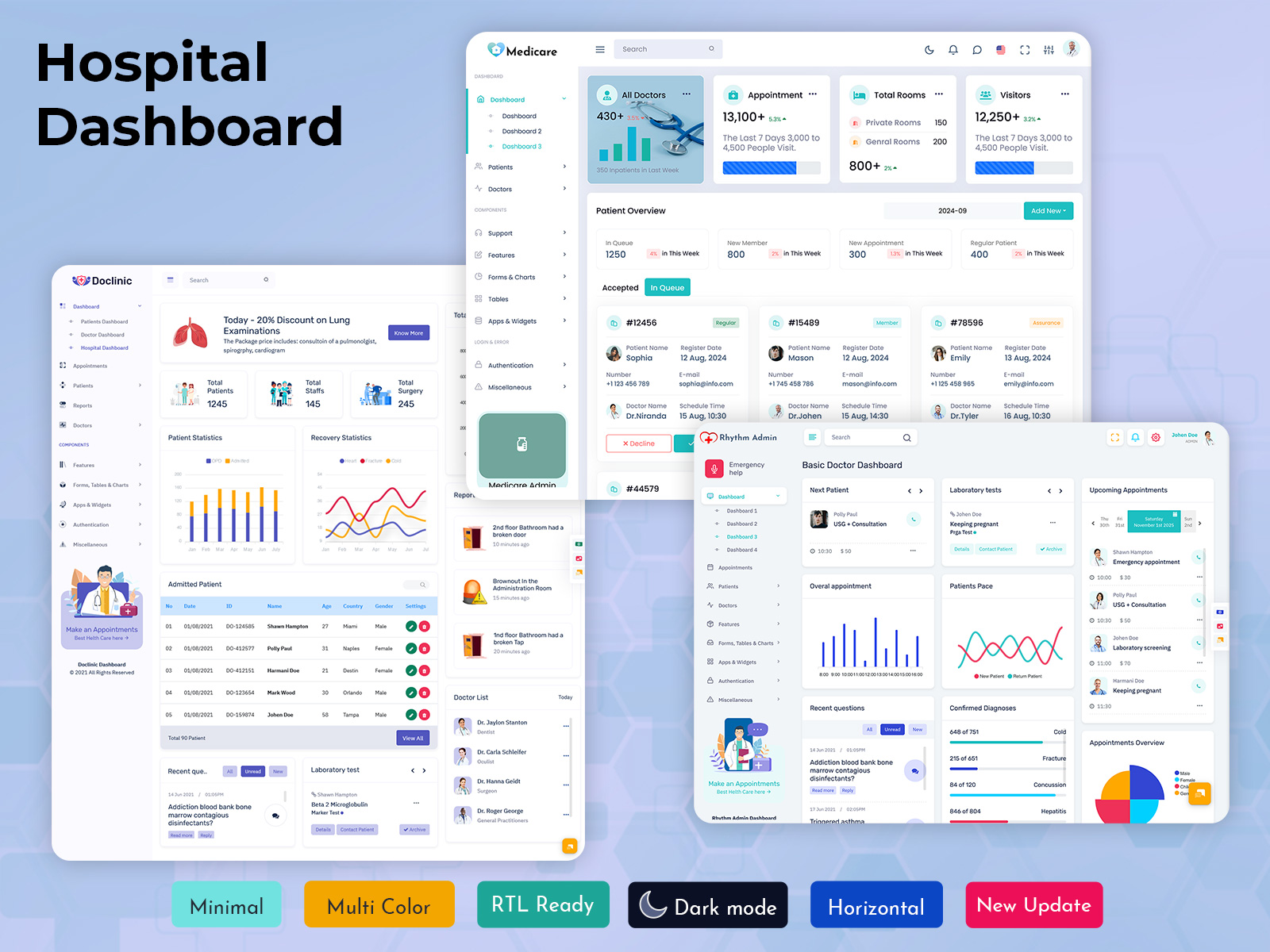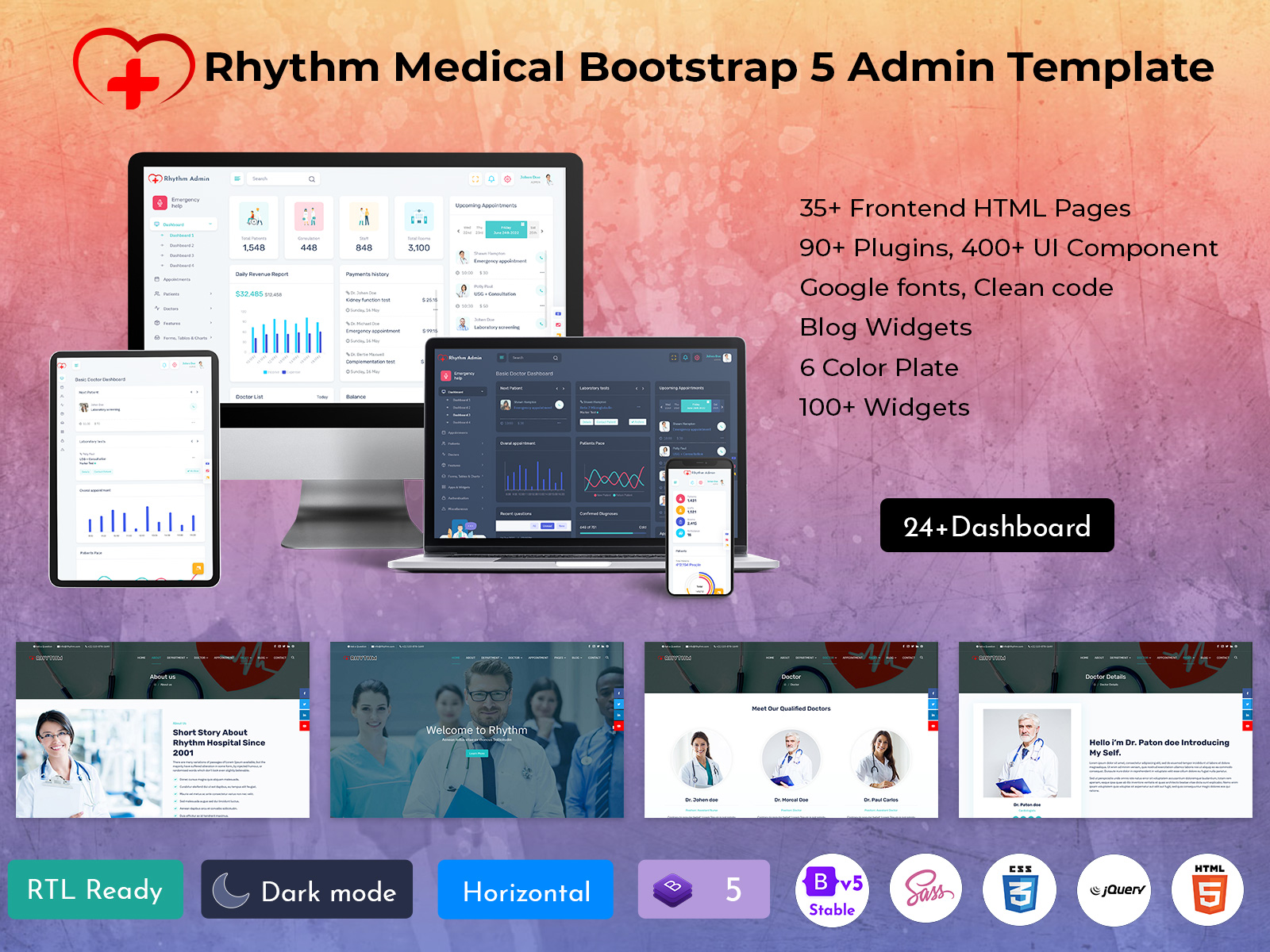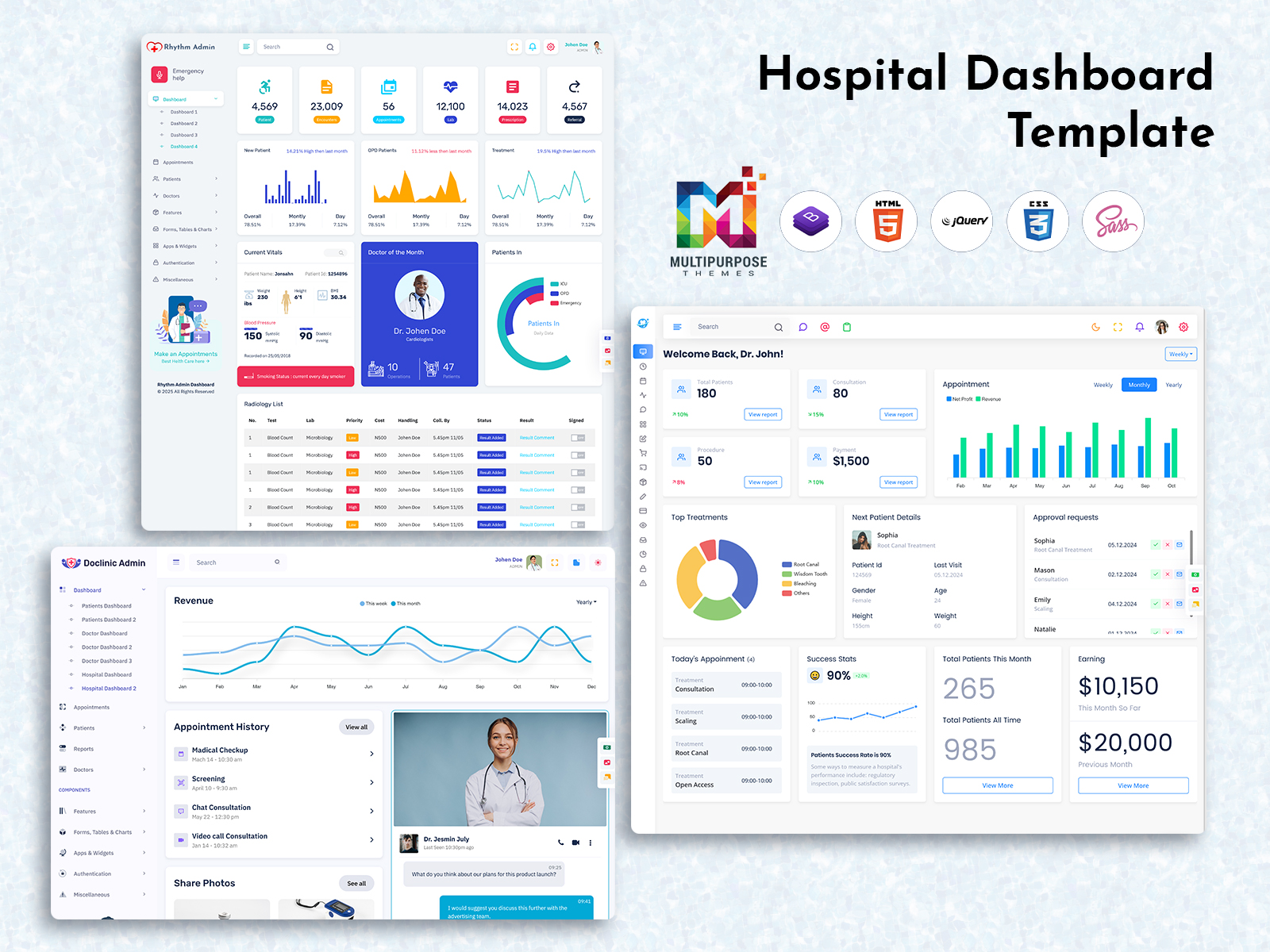A hospital dashboard brings all your important health data together in one place. Think of…

Hospital Dashboard to Manage Hospital Operations
Reading Time: 6 minutes
In the fast-paced environment of a hospital, efficient management is key to ensuring smooth operations and quality patient care. With the increasing demand for better healthcare services, hospital administrators need effective tools that can help them streamline hospital operations. A Hospital Dashboard is one such tool that provides a visual representation of key metrics and data, helping hospital staff manage operations in real-time. By using a Hospital Dashboard Template built with Bootstrap 5, hospitals can better track patient care, resource allocation, and key performance indicators (KPIs), improving decision-making, operational efficiency, and patient outcomes.
In this blog, we’ll dive into the key features of a Hospital Admin Dashboard, how it can be implemented, and the benefits of using a Medical Dashboard Template to manage hospital operations effectively.
Oral Admin – Dentist Dashboard Template
Before diving into the broader aspects of Hospital Dashboards, let’s take a look at a specialized Doctor Dashboard—the Oral Admin. This template is built specifically for dental practices and offers all the features needed for efficient dental practice management. Built with the Bootstrap 5 Admin Template, this medical dashboard is fully responsive, ensuring accessibility across all devices.
Some key features of Oral Admin include:
– Schedule management for doctors and patients.
– Real-time tracking of patient visits and financial data.
– Easy-to-use interface for dentists and administrative staff.
Whether you’re running a general practice or a specialized dental office, the Oral Admin template helps streamline operations, making it easier for doctors and administrators to manage appointments, monitor doctor schedules, and track treatment progress.
Dashboards of Oral Admin
Light Dashboard

BUY NOW DEMO
Dark Dashboard

BUY NOW DEMO
The Role of Hospital Dashboards in Healthcare Management
Imagine a busy emergency room. Patients are waiting, doctors are rushing, and nurses are scrambling. Did you know that nearly one-third of hospital costs are attributed to administrative inefficiencies? A Hospital Dashboard is the solution. It’s a game-changer for streamlining operations, boosting decision-making, and improving how hospitals care for people. By providing real-time insights into key metrics, a Hospital Dashboard allows hospital staff to make informed decisions that directly impact patient care.
Key Performance Indicators (KPIs) for Hospital Management
A Hospital Dashboard should track key performance indicators (KPIs) that provide insights into how the hospital is functioning. KPIs are vital for measuring performance, ensuring efficient resource allocation, and improving patient care.
1. Patient Satisfaction Scores
Happy patients are essential for the reputation of any healthcare facility. Patient satisfaction scores indicate how well a hospital meets the needs of its patients. Metrics like the Net Promoter Score (NPS) and satisfaction surveys help hospitals gauge patient satisfaction. By analyzing dashboard insights, hospitals can identify areas for improvement—such as long wait times—and take steps to improve the patient experience.
2. Bed Occupancy Rate
Efficient bed management is crucial for both financial health and patient flow. An ideal bed occupancy rate ensures that rooms are available for incoming patients without overcrowding. The optimal occupancy rate for hospitals typically hovers around 85%. Strategies for optimizing this rate include better discharge planning and patient transfer policies.
3. Average Length of Stay (ALOS)
The Average Length of Stay (ALOS) is the average time a patient spends in the hospital. This metric is essential for resource allocation and can significantly impact hospital costs. Reducing ALOS without compromising the quality of care is a key objective for hospital management. Optimized discharge processes and coordinated care contribute to reduced ALOS.
Benefits of Implementing a Hospital Dashboard
A Hospital Dashboard system can offer significant benefits to hospital operations. These dashboards not only improve decision-making but also enhance overall operational efficiency and lead to better patient outcomes.
1. Improved Decision-Making
Real-time data visualization empowers hospital leaders to make informed, timely decisions. Dashboards present data in an easy-to-understand format, allowing staff to identify issues quickly and take proactive measures. By having a clear view of hospital operations, leaders can allocate resources more efficiently and address operational challenges before they escalate.
2. Enhanced Operational Efficiency
With the help of a Medical Dashboard, hospitals can streamline workflows and reduce bottlenecks. These dashboards improve data accessibility, making it easier for staff to find and use the information they need. A well-organized Hospital Admin Dashboard helps ensure that tasks are completed on time, improving overall efficiency.
3. Better Patient Outcomes
Improved decision-making and operational efficiency lead to better patient outcomes. When hospital staff can quickly access relevant data and track the progress of treatment, they can offer quicker responses and better care. This results in improved patient satisfaction and enhanced healthcare delivery.
Check Our Other Admins – Hospital/Medical Dashboard
1. Doclinic Admin
BUY NOW DEMO
2. Rhythm Admin
BUY NOW DEMO
3. Medicare Admin
BUY NOW DEMO
Essential Features of an Effective Hospital Dashboard
An effective Hospital Dashboard needs to offer several key features to help hospital staff manage operations smoothly.
1. Real-Time Data Visualization
An interactive Hospital Admin Template should provide real-time data visualization, making it easier to spot trends and patterns in patient care, staffing, and other key metrics. Features like interactive charts, graphs, and maps allow staff to quickly analyze complex data and make informed decisions.
2. Customizable Reporting
Customizable reporting allows hospital staff to generate reports based on specific needs. Whether tracking patient satisfaction, occupancy rates, or staff performance, dashboards allow users to create tailored reports to focus on what matters most to them. This ensures that hospital staff can make decisions based on accurate and relevant data.
3. Role-Based Access Control
Data security and patient privacy are critical in healthcare. A good Hospital Admin Dashboard will have role-based access control, ensuring that only authorized staff can access sensitive patient data. This feature helps protect patient confidentiality while enabling staff to access the information they need for efficient hospital management.
Implementing a Hospital Dashboard: A Step-by-Step Guide
To implement a Hospital Dashboard, hospitals should follow a structured approach. Below is a step-by-step guide:
1. Define Goals and Objectives
The first step is to define what the hospital wants to achieve with the dashboard. Whether the goal is to reduce patient wait times, improve patient satisfaction, or optimize bed occupancy, clear goals will guide the dashboard implementation.
2. Choose the Right Dashboard Solution
Next, choose a Hospital Dashboard Template or solution that fits the hospital’s needs. Consider factors like ease of use, cost, and integration with existing systems. Ensure that the chosen solution aligns with the hospital’s objectives and is customizable to meet specific needs.
3. Train Staff and Promote Adoption
Training is crucial for ensuring that hospital staff can use the dashboard effectively. Provide training sessions to help staff understand how to navigate the dashboard, interpret data, and use insights to improve hospital operations. Encourage a data-driven culture within the hospital by making staff aware of the benefits of using the dashboard regularly.
The Future of Hospital Dashboards: AI and Predictive Analytics
The future of Hospital Dashboards looks promising, with AI and predictive analytics playing an increasingly important role in optimizing hospital operations.
1. Predictive Modeling for Resource Allocation
Artificial intelligence can help predict patient volumes and equipment failures, allowing hospitals to optimize staffing levels and reduce operational costs. Predictive analytics can forecast patient needs and help hospitals plan ahead to ensure adequate resources are available.
2. Personalized Patient Care Through Data Analysis
Hospital dashboards can use data analysis to personalize patient care. By combining data from different sources, dashboards can create a comprehensive view of each patient’s health, enabling doctors to tailor treatment plans accordingly. This leads to better patient outcomes and more efficient care delivery.
MPT: Best at Providing Admin Templates
MPT is a leader in providing the best admin templates for hospitals, doctors, and medical professionals. By offering a range of Hospital Admin Templates, Doctor Dashboard Templates, and Patient Dashboard Template, MPT ensures that healthcare facilities can effectively manage their operations with ease.
Benefits of Using MPT:
– High-Quality Templates: MPT provides highly responsive, modern Hospital Dashboard Templates that can be easily customized to suit the needs of any healthcare facility.
– User-Friendly Interface: All MPT templates are designed with simplicity and functionality in mind, making it easy for hospital staff to manage operations.
– Comprehensive Solutions: MPT offers a wide variety of templates, from Doctor Admin Templates to Medical Dashboard Templates, ensuring that hospitals can streamline every aspect of their operations.
Save Your Time:
By using MPT’s Dashboard Templates and Medical Admin Templates, hospitals can save valuable time that would otherwise be spent on creating a custom dashboard from scratch. MPT’s templates are ready-to-use, customizable, and designed to meet the specific needs of healthcare facilities, enabling faster deployment and less time spent on setup.
Conclusion
In conclusion, implementing a Hospital Dashboard is a vital step toward improving hospital operations and patient care. By using a Hospital Admin Template or Medical Dashboard Template, healthcare facilities can track key performance indicators, improve decision-making, and enhance operational efficiency. MPT’s Hospital Dashboard Templates offer comprehensive solutions to manage hospital operations effectively, saving time, money, and effort while improving patient outcomes. Embrace data-driven management and streamline your hospital operations with MPT’s high-quality templates.
Buy Now and Get Started Today!
Click below to purchase and start unlocking the full potential of your business!
 skip to Main Content
skip to Main Content




This Post Has 0 Comments